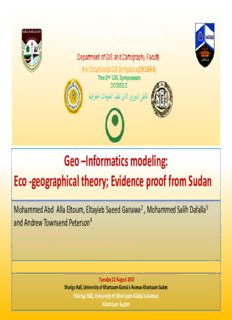
Mohamed Abd Alla Eltoum PDF
Preview Mohamed Abd Alla Eltoum
Geo –Informatics modeling: Eco -geographical theory; Evidence proof from Sudan Mohammed Abd Alla Eltoum, Eltayieb Saeed Ganawa2 , Mohammed Salih Dafalla3 and Andrew Townsend Peterson4 . *[email protected] *Assistant professor—Sudan university of Science and Technology , Tuesday 22 August 2017 Shariga Hall, University of Khartoum-Gama’a Avenue Khartoum Sudan Shariqa Hall, University of Khartoum-Gama’a Avenue Khartoum Sudan Presentation Table of Contents • Background- Introduction • Aim/objectives/study area-framework • Material and Methods • Analysis • Results and discussion • Conclusion • Acknowledgement • References Background- Introduction • Different Ecological Zones were distributed geographically around the world during the past centuries. • This support the occurrence, reproduction and survival of many living biomass. • The basic low of the Eco-geographical theory is that the change of these living biomass represent the change of it is ecological zone in a diverse relation model. • Eco geographical studies provide information on ecological region; adaption, genetic resources, habitat, distributions and land cover (Quijano et al, 2011 ). • Elements for the analysis include biotic variables (associated species, co-occurrence with competitors, pest, disease, herbivores and mutualisms), vegetation, human beings population, animals, insects and soil microorganisms figure (1). living Ecogeographical zone eco.geo. organism analysis model eco.geo. model Abiotic Biotic Factors parameters and variables Figure (1): Methodology and problem characterization. Aim/objectives/study area-framework • To validate the theory one desert spp and it is Eco zone were chosen to generate the model. • Although the term eco geography presents in many research papers, this is the first paper that build the theory. • The study area was Sudan. It is a northeast African country at latitudes 14ºand 22º North and longitudes 22º and 38ºEast Figure (2). • Figure (3.1) depicts the research strategy. From an eco-geographical analysis of both desertification and locust infestation distribution, models and sub- models were developed to explain the interaction and interrelation between these two phenomena. Figure (3) : Study area Expert knowldge Field Remote survey sensing conceptualization phase Litreature GIS Case reports Figure (4): Knowledge acquisitions. Material and Methods • From an eco-geographical analysis of both desertification and locust infestation distribution, models and sub-models were developed to explain the interaction and interrelation between these two phenomena.
Description: